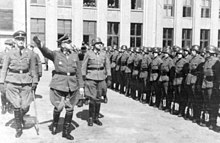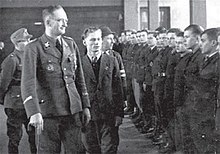Curt von Gottberg
Curt Gustav Friedrich Walther von Gottberg (born February 11, 1896 in Preußisch Wilten , † May 31, 1945 in Lutzhöft ) was a high-ranking member of the SS and a war criminal . He joined in March 1943 to July 1944, the highest civilian and military authority in White Russia ( Belarus ) in personal union . During the collapse of Army Group Center , he rose to the position of Higher SS and Police Leader (HSSPF) for Central Russia and Belarus at the beginning of July 1944 . Von Gottberg had been SS-Obergruppenführer and General of the Waffen SS since June 30, 1944 .
Origin and family
Curt von Gottberg came from the old behind Pomeranian noble family von Gottberg . He began training in agriculture in 1912.
First World War
Von Gottberg joined the Prussian Army as a volunteer on August 2, 1914 , at the beginning of the First World War and took part in the fighting until November 1918. In 1917 he was declared war-damaged because of his numerous gunshot and splinter wounds. Awarded the Iron Cross 2nd and 1st class, he was a first lieutenant in the Reichswehr until April 1920 .
Weimar Republic
After his release, von Gottberg joined the Ehrhardt Marine Brigade along with other demobilized Reichswehr officers . In November 1923 he took part in the Hitler putsch in Munich .
In 1924 he returned to East Prussia , finished his agricultural training and was an independent settlement entrepreneur in Königsberg until the end of the 1920s . In 1931 he joined the SA and in February 1932 the NSDAP ( membership number 948.753). In September 1932 he switched to the SS (SS no. 45.923).
Career in the SS
Shortly after the seizure of power experienced Adolf Hitler on 30 January 1933 Curt von Gottberg numerous promotions within the SS hierarchy. On November 6, 1933, he was promoted to SS-Sturmbannführer . At the end of 1933 he became head of the SS disposable troops in Ellwangen, Württemberg . The establishment of a military force as the basis of the future Waffen-SS prompted the SS leadership to fall back on military personnel trained during the First World War.
In 1936 von Gottberg was to take over the leadership of the 49th SS standard in Braunschweig . In January 1936, however, he caused a car accident in a strange vehicle after a carousing party. Gottberg's left leg had to be amputated below the knee. Himmler personally intervened in favor of the Gottbergs. The costs for medical follow-up care and rehabilitation as well as for the destroyed car were covered. Himmler arranged for von Gottberg to be appointed head of the Settlement Office in the Race and Settlement Main Office (RuSHA) of the SS in July 1937 . However, von Gottberg was unable to cope with this task, as his administrative experience was limited to agriculture. He was replaced by Wilhelm Freiherr von Holzschuher in 1939 .
In the summer of 1939 Gottberg received a post as acting head of the “Prague Land Office” in the Reich Protectorate of Bohemia and Moravia . Gottberg's financial conduct, which included dubious transactions, loans to private individuals, insufficient supervision of subordinates and loss-making deals in the millions, led to a tangible scandal within the RuSHA. In November 1939 the head of the RuSHA prompted Pancke von Gottberg to resign.
After "house arrest" and several interventions, von Gottberg became head of the registration office in the SS main office on October 1, 1940 . The lengthy disciplinary proceedings at the Hauptamt SS court came to an end in April 1942 with von Gottberg's rehabilitation. Although he made “factual mistakes” and made “inappropriate dispositions” , he was given credit for having acted with “remarkable momentum” , “willingness to take responsibility” and “personal devotion” .

Von Gottberg, who was sponsored by Himmler and from June 1942 SS and Police Leader (SSPF) for the general district of Belarus , was able to prove his "SS leadership ability" between October 1942 and June 1944 as an expert in "gang-fighting operations". Whole regions were declared "gang areas", the residents kidnapped or murdered, the houses destroyed. Von Gottberg developed new strategies for fighting partisans on the territory of the Soviet Union. In a dense series of commandos, the " Kampfgruppe von Gottberg " attacked suspected partisan bases. Since March 14, 1943, von Gottberg was also a representative of the HSSPF Russia-Center, Erich von dem Bach-Zelewski , the "representative of the Reichsführer-SS for fighting gangs" or "chiefs of the gang fighting units". On September 27, 1943, he was entrusted with the maintenance of the affairs of the General Commissioner of Belarus, Wilhelm Kube , who was killed by a bomb in Minsk on September 22, 1943 .
“In the evacuated room,” said von Gottberg in an order dated August 1, 1943, “the people will be fair game in the future ”. A deployment order from the Gottbergs dated December 7, 1942 read as follows:
On the occasion of his first company "Nürnberg", von Gottberg reported on December 5, 1942:
"Enemy dead: 799 bandits, over 300 suspects and over 1,800 Jews. […] Personal losses: 2 dead and 10 wounded. You have to be lucky. "
The “Kampfgruppe von Gottberg”, together with the “ Sonderkommando Dirlewanger ” and the “ Kaminski Brigade ”, coordinated by Bach-Zelewski, was responsible for countless mass murders of civilians in Belarus. For example at the “Company Harvest Festival I” from 18.1. to January 26, 1943 with the result: 805 enemy deaths, 1,165 specially treated (murdered) with own losses of 6 dead and 17 wounded and “Harvest Festival II” from January 28th. to February 9, 1943 with 2,325 enemy dead and own losses of 5 dead and 38 wounded. In November 1943 the combat group, together with the combat group “ Jeckeln ”, carried out the “Operation Heinrich”, which had to be broken off due to a Soviet offensive.
In contrast to Wilhelm Kube , Gottberg was a decided opponent of greater Belarusian autonomy. Nonetheless, he was forced to work with local officials. On December 21, 1943, at Gottberg's instigation, the Belarusian Central Council was founded, which acted as a puppet state for the occupiers. The Belarusian Home Guard was also founded on February 23, 1944 , an association of Belarusian soldiers, which was used to fight partisans.
Gottberg, who received the highest military awards within a short time , was named "HSSPF Central Russia and Belarus" on June 21, 1944, one day before the start of Operation Bagration , which led to the collapse of Army Group Center, and on June 30 Promoted to SS-Obergruppenführer in 1944.
During the hasty withdrawal from Belarus, the SS police units under Gottberg's command were deployed against the Red Army. Despite the threatening military situation, von Gottberg's troops murdered many residents of Borissow and other places. Von Gottberg refused to be placed under the military command of the Wehrmacht .
Von Gottberg was supposed to be the head of the "fight against gangs" in occupied France , but this could no longer be carried out due to the rapid advance of the Allies. From August 7, 1944 to October 18, 1944 von Gottberg was the commanding general of the XII. SS Army Corps .
In March 1945 von Gottberg received the order from Himmler to monitor the German railway network for deserting soldiers. He was entrusted by Goebbels with the remobilization of soldiers who had already been discharged from the Wehrmacht. At the end of the war he followed the so-called rat line north to Flensburg .
post war period
After the end of the war, von Gottberg was arrested. He committed on 31 May 1945 in Lutzhöft in Flensburg in British captivity suicide .
See also
literature
- Ruth Bettina Birn : The Higher SS and Police Leaders. Himmler's representative in the Reich and in the occupied territories. Droste Verlag, Düsseldorf 1986, ISBN 3-7700-0710-7 .
- Christian Gerlach : Calculated murders. The German economic and annihilation policy in Belarus 1941 to 1944. Hamburger Edition, Hamburg 2000, ISBN 3-930908-63-8 .
- Ernst Klee : The dictionary of persons on the Third Reich. Who was what before and after 1945 ; Fischer Taschenbuch Verlag Frankfurt am Main 2005, 2nd updated edition, ISBN 3-596-16048-0 .
- Peter Klein: Curt von Gottberg. In: Klaus-Michael Mallmann & Gerhard Paul (eds.): Careers of violence. National Socialist perpetrator biographies. WBG , Darmstadt 2004, ISBN 3-534-16654-X ; 2nd rev. 2005; including special edition WBG 2011 & Primus, Darmstadt 2011, ISBN 978-3-89678-726-2 .
- Brün Meyer (Hrsg.): Seniority list of the Waffen-SS: SS-Obergruppenführer to SS-Hauptsturmführer. Status from July 1, 1944 with amendments up to January 30 , 1945 ; Biblio-Verlag, 1987, ISBN 3-7648-1469-1 .
- Detlef Brandes : "Umvolkung, Umsiedlung, racial inventory": Nazi "Volkstumsppolitik" in the Bohemian countries . Oldenbourg, Munich, 2012, ISBN 978-3-486-71242-1 .
Remarks
- ↑ Curt von Gottberg was never brought to justice for his suicide and was not convicted of war crimes.
Individual evidence
- ↑ Seniority list of the Waffen-SS from July 1, 1944. Serial. No. 21a (as Kurt von Gottberg)
- ↑ Klee: The personal dictionary for the Third Reich. P. 193.
- ↑ Klein: Curt von Gottberg. P. 96.
- ↑ Detlef Brandes: Umvolkung, resettlement, racial inventory . 2012 passim
- ↑ Wolfgang Curilla : The German Ordnungspolizei and the Holocaust in the Baltic States and in Belarus 1941-1944. P. 738.
- ^ Curilla: The German Ordnungspolizei and the Holocaust in the Baltic States and Belarus 1941-1944. P. 722 ff.
- ↑ Alexander Brakel: Under Red Star and Swastika. Baranowicze 1939 to 1944. Western Belarus under Soviet and German occupation . (= Age of World Wars. Volume 5). Ferdinand Schöningh Verlag, Paderborn u. a. 2009, ISBN 978-3-506-76784-4 , p. 219.
- ↑ Stephan Link: "Rattenlinie Nord". War criminals in Flensburg and the surrounding area in May 1945. In: Gerhard Paul, Broder Schwensen (Hrsg.): Mai '45. End of the war in Flensburg. Flensburg 2015, p. 22.
- ↑ Flensburger Tageblatt : The final resting place: perpetrators and victims lie on the "Peace Hill" , from: May 19, 2015; Retrieved on: June 29, 2017
| personal data | |
|---|---|
| SURNAME | Gottberg, Curt von |
| ALTERNATIVE NAMES | Gottberg, Curt Gustav Friedrich Walther von (full name) |
| BRIEF DESCRIPTION | German SS-Obergruppenführer |
| DATE OF BIRTH | February 11, 1896 |
| PLACE OF BIRTH | Prussian Wilten |
| DATE OF DEATH | May 31, 1945 |
| Place of death | Flensburg |
